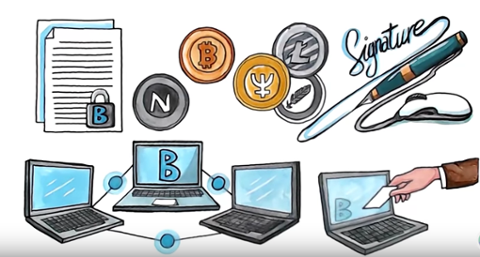[caption id="attachment_145371" align="aligncenter" width="5700"]

Blockchain[/caption] If there’s one thing 2017 has taught us, it’s that we have some serious security issues in tech. Hacks, leaks and white-hat hackers alike shone a light on security this past year – but precious few solutions to our worst issues have surfaced. Is blockchain
the way forward? The ‘blockchain’ concept is often tied to cryptocurrency like Bitcoin, and for good reason. In a nutshell, blockchain closely tracks transactions for digital goods or services. It also relies on trusted users, often based on how many transactions they make. A good comparison may be return customers to a small market; the more they frequent the establishment, the more the owners and staff learn their name and purchasing habits. Over time, that person is a known entity. Transactions are another cryptocurrency tie-in, but the term is also interchangeable with any transfer of information. At its core, blockchain is meant to allow trusted users and devices to exchange packets of data via a system of crowdsourced trust. Another savvy feature is that blockchain devices each have their own database that must be reconciled each time a transaction is initiated. If things don’t match up, the process is halted. This works well because there isn’t a centralized database to corrupt, and one point of failure means the entire process is disrupted. A hacker would have to control at least half the machines on a network to corrupt the blockchain. Strength in numbers is valuable, here.
Dr. Balakrishnan Dasarathy of the University of Maryland’s Cyber Operations program says blockchain may prove critical in 2018:
Blockchain technology’s disruptive aspect is its potential to eliminate intermediaries, such as government agencies, banks, clearing houses and companies like Uber, Airbnb and eBay. Blockchain provides these and other companies a measure of speed and cost savings when executing transactions. The blockchain shared, distributed and replicated ledger allows transacting parties to directly update the shared ledger for every transaction. Since parties interact directly through the shared ledger, they have to trust each other, and the transaction records in the shared ledgers should be visible only to the right parties. As such, cybersecurity technologies, specifically cryptography and access control, are critical enabling technologies for blockchain.
In a TEDx talk, ‘futurist’
Ian Khan said: “Blockchain truly is a mechanism to bring everyone to the highest degree of accountability. No more missed transactions, human or machine errors, or even an exchange that was not done with the consent of the parties involved. Above anything else, the most critical area where Blockchain helps is to guarantee the validity of a transaction by recording it not only on a main register but a connected distributed system of registers, all of which are connected through a secure validation mechanism.” Vitalik Buterin, inventor of computing platform
Ethereum (and cryptocurrency ‘Ether’), suggested that blockchain “solves the problem of manipulation.” [caption id="attachment_132771" align="aligncenter" width="1000"]

Security[/caption]
Getting Started in Blockchain
If you want to get involved in Bitcoin, there is no shortage of services that can help you spin up your own wallet. That’s not what we’re talking about, though. Using blockchain for business purposes, often referred to ‘blockchain-as-a-service’ (because everything has to be ‘as-a-service’ now), is actually sort of rare. Luckily, two giants in the industry have widely accepted it, and founded clear paths for entry. Microsoft has
woven blockchain into Azure. Based on Ethereum, it leans into Linux and virtual machines to help you get up and running with blockchain in five straightforward steps. Microsoft also seats its blockchain tooling under its ‘labs’ profile, which “helps developers and testers quickly create environments in Azure while minimizing waste and controlling cost.” It also has a GitHub repo where development is going on. IBM’s
solution is a bit more polished. Whereas Microsoft allows you to create a blockchain instance, IBM handles the satellite features, as well. In addition to developer environments, IBM Blockchain generates chaincodes and contracts, and interoperates with the Linux Foundation’s Hyperledger Composer. It can be used to develop a blockchain application, or spin up an entire network. Heading into 2018, security is not a factor we’re able to overlook anymore. Leading experts agree blockchain is secure, despite the hiccups Bitcoin has endured. It’s not perfect, but hacking or compromising a blockchain system for gain requires a lot more work than may be worthwhile for bad actors. If nothing else, it may be the most secure solution we have for now, depending on the application or service you're trying to build.
 Blockchain[/caption] If there’s one thing 2017 has taught us, it’s that we have some serious security issues in tech. Hacks, leaks and white-hat hackers alike shone a light on security this past year – but precious few solutions to our worst issues have surfaced. Is blockchain the way forward? The ‘blockchain’ concept is often tied to cryptocurrency like Bitcoin, and for good reason. In a nutshell, blockchain closely tracks transactions for digital goods or services. It also relies on trusted users, often based on how many transactions they make. A good comparison may be return customers to a small market; the more they frequent the establishment, the more the owners and staff learn their name and purchasing habits. Over time, that person is a known entity. Transactions are another cryptocurrency tie-in, but the term is also interchangeable with any transfer of information. At its core, blockchain is meant to allow trusted users and devices to exchange packets of data via a system of crowdsourced trust. Another savvy feature is that blockchain devices each have their own database that must be reconciled each time a transaction is initiated. If things don’t match up, the process is halted. This works well because there isn’t a centralized database to corrupt, and one point of failure means the entire process is disrupted. A hacker would have to control at least half the machines on a network to corrupt the blockchain. Strength in numbers is valuable, here. Dr. Balakrishnan Dasarathy of the University of Maryland’s Cyber Operations program says blockchain may prove critical in 2018:
Blockchain[/caption] If there’s one thing 2017 has taught us, it’s that we have some serious security issues in tech. Hacks, leaks and white-hat hackers alike shone a light on security this past year – but precious few solutions to our worst issues have surfaced. Is blockchain the way forward? The ‘blockchain’ concept is often tied to cryptocurrency like Bitcoin, and for good reason. In a nutshell, blockchain closely tracks transactions for digital goods or services. It also relies on trusted users, often based on how many transactions they make. A good comparison may be return customers to a small market; the more they frequent the establishment, the more the owners and staff learn their name and purchasing habits. Over time, that person is a known entity. Transactions are another cryptocurrency tie-in, but the term is also interchangeable with any transfer of information. At its core, blockchain is meant to allow trusted users and devices to exchange packets of data via a system of crowdsourced trust. Another savvy feature is that blockchain devices each have their own database that must be reconciled each time a transaction is initiated. If things don’t match up, the process is halted. This works well because there isn’t a centralized database to corrupt, and one point of failure means the entire process is disrupted. A hacker would have to control at least half the machines on a network to corrupt the blockchain. Strength in numbers is valuable, here. Dr. Balakrishnan Dasarathy of the University of Maryland’s Cyber Operations program says blockchain may prove critical in 2018:
 Security[/caption]
Security[/caption]



